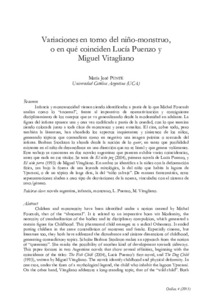Por favor, use este identificador para citar o enlazar este ítem:
https://repositorio.uca.edu.ar/handle/123456789/15080| Título: | Variaciones en torno del niño-monstruo, o en qué coinciden Lucía Puenzo y Miguel Vitagliano Variations around the phantasmal child, or the coincidence between Lucía Puenzo and Miguel Vitagliano |
Autor: | Punte, María José | Palabras clave: | NOVELA ARGENTINA; LITERATURA ARGENTINA; Puenzo, Lucía, 1976-; Vitagliano, Miguel; INFANCIA | Fecha de publicación: | 2015 | Editorial: | Universidad de Padua | Cita: | Punte, M. J. Variaciones en torno del niño-monstruo, o en qué coinciden Lucía Puenzo y Miguel Vitagliano [en línea]. Orillas. 2015, 4. Disponible en: https://repositorio.uca.edu.ar/handle/123456789/15080 | Resumen: | Resumen: Infancia y monstruosidad vienen siendo identificadas a partir de lo que Michel Foucault
analiza como lo “anormal”, frente al imperativo de normativización y consiguiente
disciplinamiento de los cuerpos que se va generalizando desde la modernidad en adelante. La
figura del infante aparece una y otra vez codificada a partir de la otredad, con lo que termina
siendo colocada junto a toda clase de monstruos y seres extraños. El cine, sobre todo, pero
también la literatura, han abordado los aspectos inquietantes y siniestros de los niños,
generando tópicos que contradicen como en negativo una imagen prístina o asexuada del
infante. Barbara Stockton lo aborda desde la noción de lo queer, en tanto que posibilidad
existente en el niño de desarrollarse en una dirección que no es lineal y que genera volúmenes.
Este trabajo se concentra en dos novelas argentinas que parecen exhibir varias coincidencias,
antes que nada en sus títulos. Se trata de El niño pez (2004), primera novela de Lucía Puenzo, y
El niño perro (1993) de Miguel Vitagliano. En ambas se identifica a la niñez con la deformación
física, sea bajo la forma de una leyenda mitológica, la del niño que habita la laguna de
Ypacaraí, o de un tópico de larga data, la del “niño salvaje”. De manera fantasmática, estas
representaciones aluden a otro tipo de desviaciones de la norma, vinculadas con el sistema de
sexo/género. Abstract: Children and monstrosity have been identified under a notion created by Michel Foucault, that of the “abnormal”. It is related to an imperative born wit Modernity, the necessity of standardization of the bodies and its disciplinary compulsion, which generated a certain figure for Childhood. This phantasmal child emerges as a radical Otherness. It ended putting children in the same constellation of monsters and freaks. Especially cinema, but literature too, they both have addressed the disturbance and sinister dimensions of childhood, generating contradictory topics. Scholar Barbara Stockton makes an approach from the notion of “queerness”. She marks the possibility of another kind of development towards sideways. This paper focuses in two Argentine novels that show several affinities, beginning with the coincidence of the titles: The Fish Child (2004), Lucía Puenzo’s first novel, and The Dog Child (1993), written by Miguel Vitagliano. The novels identify childhood and physical deformity. In one case, under the form of a mythological legend, the child who inhabit the lagoon Ypacaraí. On the other hand, Vitagliano addresses a long-standing topic, that of the “wild child”. Both representations refer to different kinds of deviation from the norm, in fact linked to the sex/gender system. |
URI: | https://repositorio.uca.edu.ar/handle/123456789/15080 | ISSN: | 2280-4390 (en línea) | Disciplina: | LITERATURA | Derechos: | Acceso abierto | Fuente: | Orillas. 2015, 4 |
| Aparece en las colecciones: | Artículos |
Ficheros en este ítem:
| Fichero | Descripción | Tamaño | Formato | |
|---|---|---|---|---|
| variaciones-torno-niño-monstruo.pdf | 184,19 kB | Adobe PDF |  Visualizar/Abrir |
Visualizaciones de página(s)
82
comprobado en 27-abr-2024
Descarga(s)
85
comprobado en 27-abr-2024
Google ScholarTM
Ver en Google Scholar
Este ítem está sujeto a una Licencia Creative Commons

